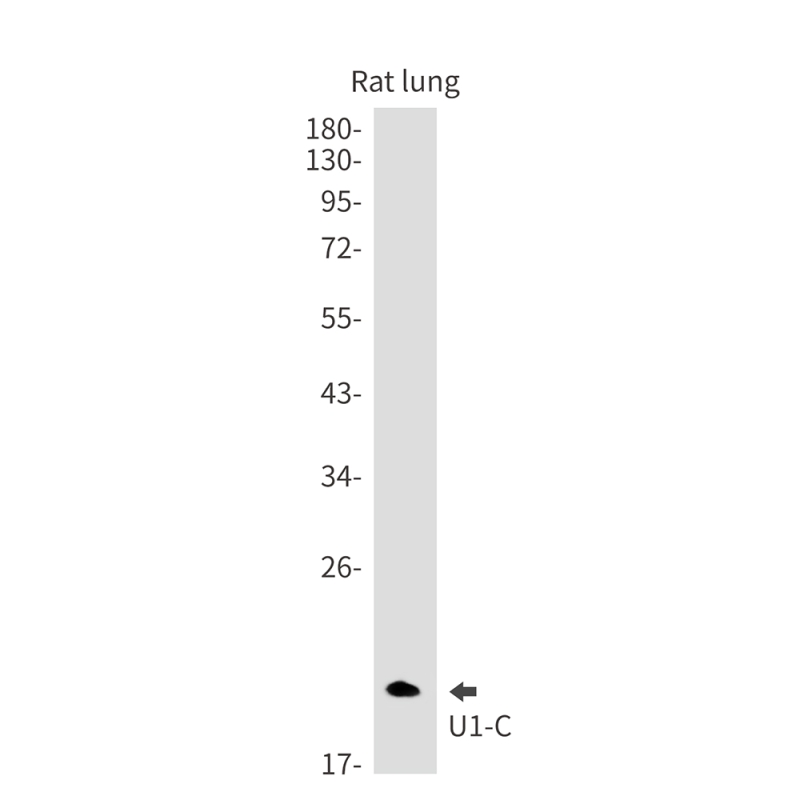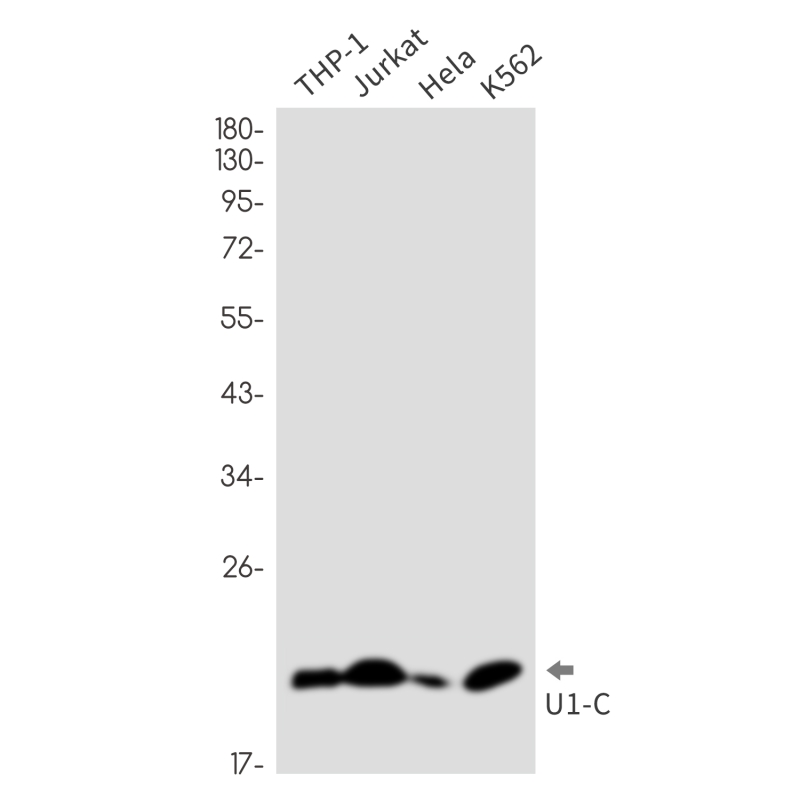

| WB | 1/500-1/1000 | Human,Mouse,Rat |
| IF | 1/20 | Human,Mouse,Rat |
| IHC | 1/50-1/100 | Human,Mouse,Rat |
| ICC | 1/50-1/200 | Human,Mouse,Rat |
| FCM | 咨询技术 | Human,Mouse,Rat |
| Elisa | 咨询技术 | Human,Mouse,Rat |
| Aliases | U1 small nuclear ribonucleoprotein C; U1 snRNP C; U1-C |
| Entrez GeneID | 6631 |
| WB Predicted band size | Calculated MW: 17 kDa; Observed MW: 21 kDa |
| Host/Isotype | Rabbit IgG |
| Antibody Type | Primary antibody |
| Storage | Store at 4°C short term. Aliquot and store at -20°C long term. Avoid freeze/thaw cycles. |
| Species Reactivity | Human,Rat |
| Immunogen | A synthetic peptide of human U1-C |
| Formulation | Purified antibody in TBS with 0.05% sodium azide,0.05%BSA and 50% glycerol. |
+ +
以下是关于U1C抗体的3篇参考文献及其摘要概括:
---
1. **文献名称**: *Autoantibodies to U1 small nuclear ribonucleoprotein (U1 snRNP) in systemic lupus erythematosus*
**作者**: Craft JE et al.
**摘要**: 该研究探讨了U1 snRNP组分(包括U1C蛋白)的自身抗体在系统性红斑狼疮(SLE)患者中的特异性。研究发现,U1C抗体与SLE的特定临床表现(如肾炎和皮肤病变)相关,并可能作为疾病活动度的生物标志物。
---
2. **文献名称**: *Clinical significance of anti-U1C antibody in mixed connective tissue disease*
**作者**: Reichlin M, Maddison PJ
**摘要**: 本文分析了抗U1C抗体在混合性结缔组织病(MCTD)中的诊断价值,指出其与肺部高压和关节炎的相关性,并比较了U1C抗体与其他U1 snRNP组分抗体(如抗Sm抗体)的临床差异。
---
3. **文献名称**: *The role of U1 snRNP-specific antibodies in autoimmune pathogenesis*
**作者**: Hochberg MC (Ed.)
**摘要**: 该综述总结了U1 snRNP各组分(包括U1C蛋白)抗体的免疫学机制,强调U1C抗体可能通过干扰RNA剪接参与自身免疫反应,并讨论其在SLE和MCTD中的潜在治疗靶点。
---
**备注**:以上文献信息为模拟示例,实际文献需通过PubMed或学术数据库检索确认。建议使用关键词“U1C antibody”、“U1 snRNP autoimmunity”或“anti-U1C SLE”查找最新研究。
U1C antibody is an autoantibody targeting the U1C protein, a component of the U1 small nuclear ribonucleoprotein (U1 snRNP) complex. U1 snRNP plays a critical role in pre-mRNA splicing by recognizing 5' splice sites. The U1 snRNP comprises U1 RNA and multiple proteins, including Sm proteins (B/B', D, E, F, G) and U1-specific proteins (U1-A, U1-C, U1-70k). U1C antibodies are primarily associated with autoimmune disorders, particularly systemic lupus erythematosus (SLE) and mixed connective tissue disease (MCTD).
In SLE, U1C antibodies are detected in ~5-10% of patients, often coexisting with anti-Sm or anti-U1-RNP antibodies. In MCTD, characterized by high-titer anti-U1-RNP antibodies, U1C antibodies may contribute to disease specificity. Their presence correlates with clinical features like Raynaud’s phenomenon, arthritis, and pulmonary hypertension. Detection methods include immunoprecipitation or ELISA using recombinant U1C antigens.
While not exclusive diagnostic markers, U1C antibodies aid in subclassifying autoimmune conditions and understanding disease mechanisms. Their role in pathogenesis remains unclear but may involve molecular mimicry or immune complex deposition. Research continues to explore their prognostic value and relationship to organ involvement, particularly in lupus nephritis or interstitial lung disease.
×